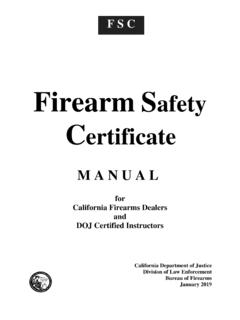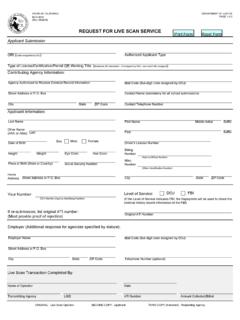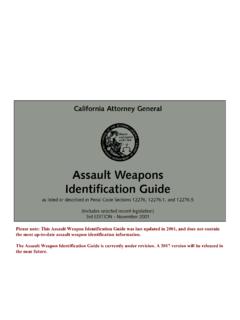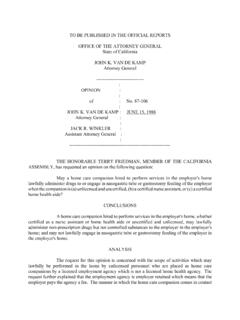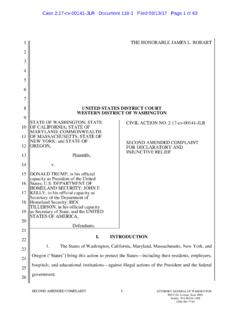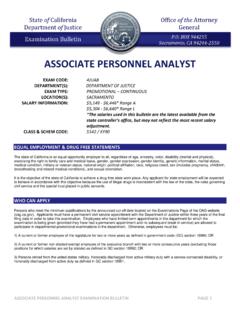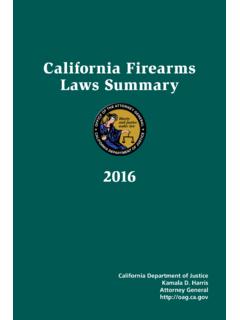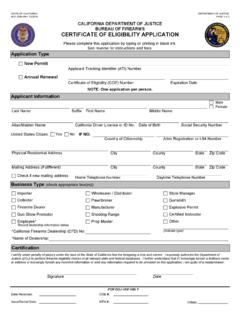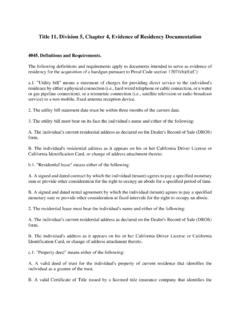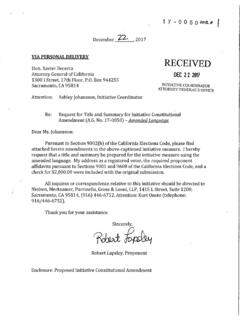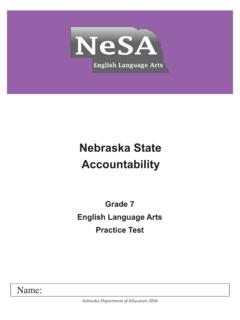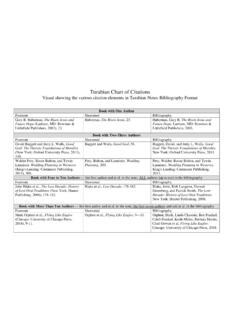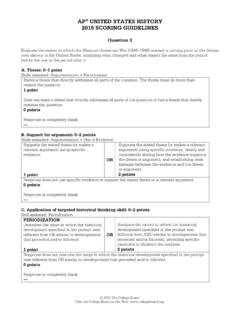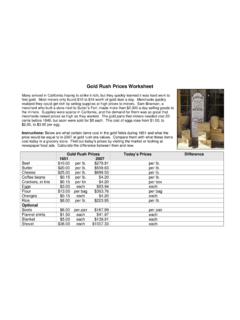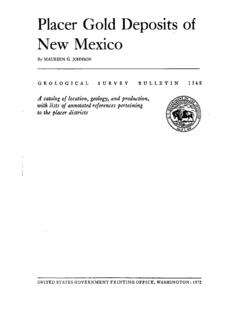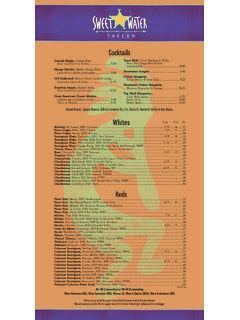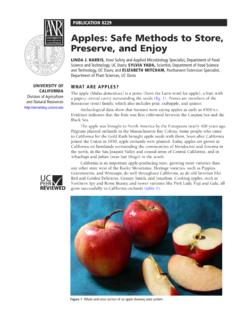Transcription of Anti-Asian Hate Crime Events During the COVID-19 Pandemic ...
1 Executive Summary At the onset of the COVID-19 Pandemic in the United States, mainstream media outlets reported an alarming increase in hate crimes specifcally targeting individuals who identify as Asian. Tis increase was linked to Anti-Asian rhetoric which blamed Asian communities for the spread of COVID-19 in the United Tis research brief report addresses Anti-Asian hate Crime Events reported to the california Department of Justice (DOJ) since 2016, with a specifc focus on hate crimes Events committed in As mandated by Penal Code (PC) section 13023, california law enforcement agencies (LEAs) are required to report information on hate crimes to the DOJ. In 2015, the DOJ expanded the race and ethnicity hate Crime bias category for the california hate Crime data collection system to include Native Hawaiian or other Pacifc Islander. As a result of this expansion, LEAs report hate crimes motivated by a bias towards Native Hawaiian or Pacifc Islanders separately from hate crimes motivated by a bias towards Asians.
2 For hate Crime data reporting purposes, Asian refers to a person having origins in any of the original peoples of the Far East, Southeast Asia, or the Indian subcontinent. Troughout this research brief report the term Anti-Asian hate Crime Events or Anti-Asian hate crimes refers to Events classifed by LEAs as motivated by an Anti-Asian bias. Tis research brief report analyzes the data reported by LEAs according to the most serious criminal ofense committed in each hate Crime event. Te data used for this report is also available on the DOJ's OpenJustice Data Portal. Te DOJ recognizes that hate crimes in the state are generally underreported and that the data presented in this report may not adequately refect the actual number of hate crimes occurring in the state that were never reported to LEAs. Tis research brief report focuses solely on reported hate crimes which are criminal acts committed, in whole or in part, because of a victim's actual or perceived disability, gender, nationality, race or ethnicity, religion, sexual orientation, or association with someone with one or more of these actual or perceived characteristics.
3 Hate incidents which are actions or behavior motivated by hate such as name-calling or distribution of materials with hate messages in public places are not included. While these acts are harmful, they are legally protected by the First Amendment right to freedom of expression and do not rise to the level of a criminal ofense under california law. However, it is important to note that these incidents have a traumatic impact on victims and communities at large. If a hate incident begins to threaten a person or property, it may become a hate Crime . Anti-Native Hawaiian or Pacifc Islander hate Crime Events reported to the DOJ have decreased since 2016. In 2019 and 2020, there were zero reports of anti-Native Hawaiian and other Pacifc Islander hate Crime Events . However, we should caution that this fnding does not mean that 1. Ali Rogin and Amna Nawaz, We Have Been Trough Tis Before.
4 ' Why Anti-Asian Hate Crimes are Rising Amid Coronavirus, PBS, June 25, 2020, available at: Anti-Asian -hate-crimes-are-rising-amid-c oronavirus. 2. california PC section defnes hate crimes as a criminal act committed in whole or in part because of a victim's actual or perceived disability, gender, nationality, race or ethnicity, religion, sexual orientation, or association with someone with one or more of these actual or perceived characteristics. 1. Native Hawaiian or Pacifc Islander people were not targeted in attacks, but that there were no reported hate Crime Events where it was found that the ofender was motivated by an animosity towards Pacifc Islanders in 2019 and 2020. Because of the increase in Anti-Asian hate Crime Events reported to the DOJ in 2020 along with no reports of hate crimes motivated by bias towards Native Hawaiian or Pacifc Islander in 2019 and 2020, this report presents information on Anti-Asian hate Crime Events reported to the DOJ in the previous fve years.
5 An analysis of hate Crime Events motivated by an Anti-Asian bias reported to the DOJ in the last fve years (2016 through 2020) found that: Te number of reported Anti-Asian hate Crime Events in california has increased since 2016. Te number of reported Anti-Asian hate Crime Events increased by 107% in 2020, from 43. in 2019 to 89 in 2020. Te highest number of Anti-Asian hate Crime Events reported to the DOJ occurred in March and April 2020 as california declared a state of emergency to help prevent the spread of COVID-19 . Overall, the most common kind of Anti-Asian hate Crime reported across years 2016 and 2020. was violent Crime , with a 125% increase from 32 in 2019 to 72 in 2020. Simple assault and intimidation were the most common type of violent crimes reported to the DOJ across the fve-year span. Te number of reported Anti-Asian property hate Crime Events (arson, burglary, destruction, damage, vandalism) increased by 55% in 2020; from 11 in 2019 to 17 in 2020.
6 For years 2016 to 2020, property damage was the most common type of property crimes reported to the DOJ. Taking into consideration data reported to the DOJ since 2016: Anti-Asian hate Crime Events commonly targeted individuals as opposed to organizations or businesses, with the majority of individuals targeted being adults over the age of 18. Te highest number of persons victimized in Anti-Asian hate Crime Events were reported to the DOJ in 2020. A total of 101 individuals were targeted in attacks reported in 2020, representing an increase of 102% from 2019 where 50 people were reported as victims in hate Crime Events . In 2020, individuals were victimized in 18 diferent california counties. Of those counties, San Luis Obispo County had the highest rate of victimization per 10,000 Asian residents (the share of the population most vulnerable to Anti-Asian hate Crime Events ). Alameda County had the lowest victimization rate per 10,000 residents.
7 2. Introduction Shortly afer the United States was placed under stay-at-home orders due to the COVID-19 . Pandemic , media reports signaled an alarming increase in hate incidents and hate crimes targeting Asian communities (specifcally, ethnic groups with origins in East Asia, Southeast Asia, or the Indian subcontinent).3, 4, 5 In March 2020, the Stop AAPI Hate Reporting Center began to formally record and publish reports on hate incidents and hate crimes committed against Asians and Pacifc Islanders to document the increase in , 7 Te rise in bias-motivated attacks against Asians During the height of the COVID-19 Pandemic is part of a long history of similar attacks against members of Asian communities dating back to the nineteenth century. Literature Review Recent academic journal articles have highlighted how attacks against Asians During the COVID-19 Pandemic are a part of a long history of discrimination against Asian communities in the United States.
8 Asian Americans are ofen stereotyped as perpetual foreigners, anti-American, and carriers of infectious disease. Tese stereotypes in turn have fueled racist beliefs that Asians are responsible for introducing COVID-19 to the United , 9, 10 In addition, commonly-held stereotypes of Asian Americans ofen ignore the ethnic diversity that exists within these racial and ethnic groups. Perpetrators of Anti-Asian violence may see all as foreign and threatening regardless of whether the person is from China, of Chinese origin, or simply looks Asian , . making all Asian people vulnerable to hate 3. Esther Yoon-Ji Kang, Asian Americans Feel the Bite of Prejudice During the COVID-19 Pandemic , NPR, March 31, 2020, available at: d-19- Pandemic . 4. Ali Rogin and Amna Nawaz, We Have Been Trough Tis Before.' Why Anti-Asian Hate Crimes are Rising Amid Coronavirus, . PBS, June 25, 2020, available at: crimes-are-rising-amid-coronavirus.
9 Rogin and Nawaz, We Have Been Trough Tis Before.' . 5. Defnitions for Asian follow defnitions provided on the Census Bureau website: 6. Asian Pacifc Policy & Planning Council, Asian American Pacifc Islander (AAPI) Civil Rights Organizations Establishes Stop AAPI Hate Reporting Center, A3 PCON, March 19, 2020, available at: asian-american-pacifc-islander-aapi-civi l-rights-organizations-establishes-stop- aapi-hate-reporting-center/. 7. Kara Takasaki, Stop AAPI Hate Reporting Center: A Model of Collective Leadership and Community Advocacy, Journal of Asian American Studies, Volume 23, Number 3, 2020, pp. 341-342. 8. Hannah Tessler, Meera Choi, and Grace Kao, Te Anxiety of Being Asian American: Hate Crimes and Negative Biases During the COVID-19 Pandemic , American Journal of Criminal Justice, 45: 636-646, 2020. 9. Angela R. Gover, Shannon B. Harper, and Lynn Langton, Anti-Asian Hate Crime During the COVID-19 Pandemic : Exploring the Reproduction of Inequality, American Journal of Criminal Justice, 45, 2020, p.
10 651. Yao Li and Harvey L. Nicholson Jr., When Model Minorities' Become Yellow Peril' Othering and the Racialization of Asian 10. Americans in the COVID-19 Pandemic , Sociology Compass, 2021:1-13, 2021. 11. Tessler et al., Te Anxiety of Being Asian American, p. 642. 3. Academic scholars have also demonstrated how politicians and mainstream media further perpetuated the notion that China, and by extension Chinese people, were responsible for the spread of COVID-19 . While in ofce, former President Donald Trump and members of his administration ofen referred to COVID-19 as Wuhan Virus, Chinese Virus, or kung fu. 12, 13, 14 Mainstream news media ofen implicitly linked COVID-19 to China through mentioning COVID-19 alongside China or juxtaposing images of China next to articles about , 16 Early studies have suggested that mainstream media coverage and rhetoric used by public ofcials contributed to the stigmatization of Asian people During the , 18.
